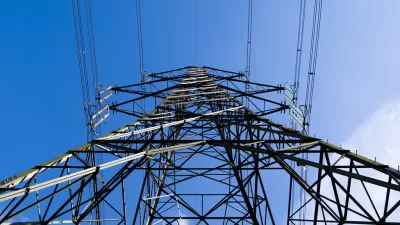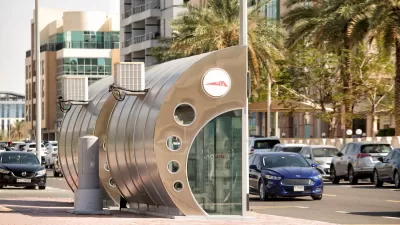A landscape architect in Tucson shares a professional lament: intrusive, ugly utilities.

Over the last decade or so, Ellen Barth Alster has noticed a trend in her county's electrical infrastructure: It’s getting uglier.
The landscape architect for the Department of Transportation in Pima County, Arizona, Alster makes clear on The Field that this is an indignity to the region’s cherished desert environment.
Where once utility infrastructure took care not to detract from the beauty of their natural surroundings, now, she writes, "aesthetics are given a passing nod, at best, in facility design." As a result, dark steel poles taller than any building have become "the most prominent landscape feature" on the open horizon.
She explains:
Local regulations written a decade ago have not kept pace with how massive the structures and facilities have become … Meanwhile, it’s a struggle to get communication providers to comply with the minimum of code requirements: siting for less visual impact, selecting environmentally compatible colors, replacing vegetation that will be impacted.
To gauge the extent of this trend anecdotally, Alster poses a few open questions to fellow professionals. Chief among them:
Are newer, larger power poles in your area being designed with visual compatibility issues in mind? Or are they becoming a dominant skyline feature?
The post is peppered with photos that clearly illustrate the contrast between tasteful utility poles to those that intrude on the protected desert landscape.
FULL STORY: When Did Scenic Quality Stop Mattering?

Alabama: Trump Terminates Settlements for Black Communities Harmed By Raw Sewage
Trump deemed the landmark civil rights agreement “illegal DEI and environmental justice policy.”

Planetizen Federal Action Tracker
A weekly monitor of how Trump’s orders and actions are impacting planners and planning in America.

The 120 Year Old Tiny Home Villages That Sheltered San Francisco’s Earthquake Refugees
More than a century ago, San Francisco mobilized to house thousands of residents displaced by the 1906 earthquake. Could their strategy offer a model for the present?

In Both Crashes and Crime, Public Transportation is Far Safer than Driving
Contrary to popular assumptions, public transportation has far lower crash and crime rates than automobile travel. For safer communities, improve and encourage transit travel.

Report: Zoning Reforms Should Complement Nashville’s Ambitious Transit Plan
Without reform, restrictive zoning codes will limit the impact of the city’s planned transit expansion and could exclude some of the residents who depend on transit the most.

Judge Orders Release of Frozen IRA, IIJA Funding
The decision is a victory for environmental groups who charged that freezing funds for critical infrastructure and disaster response programs caused “real and irreparable harm” to communities.
Urban Design for Planners 1: Software Tools
This six-course series explores essential urban design concepts using open source software and equips planners with the tools they need to participate fully in the urban design process.
Planning for Universal Design
Learn the tools for implementing Universal Design in planning regulations.
Clanton & Associates, Inc.
Jessamine County Fiscal Court
Institute for Housing and Urban Development Studies (IHS)
City of Grandview
Harvard GSD Executive Education
Toledo-Lucas County Plan Commissions
Salt Lake City
NYU Wagner Graduate School of Public Service





























